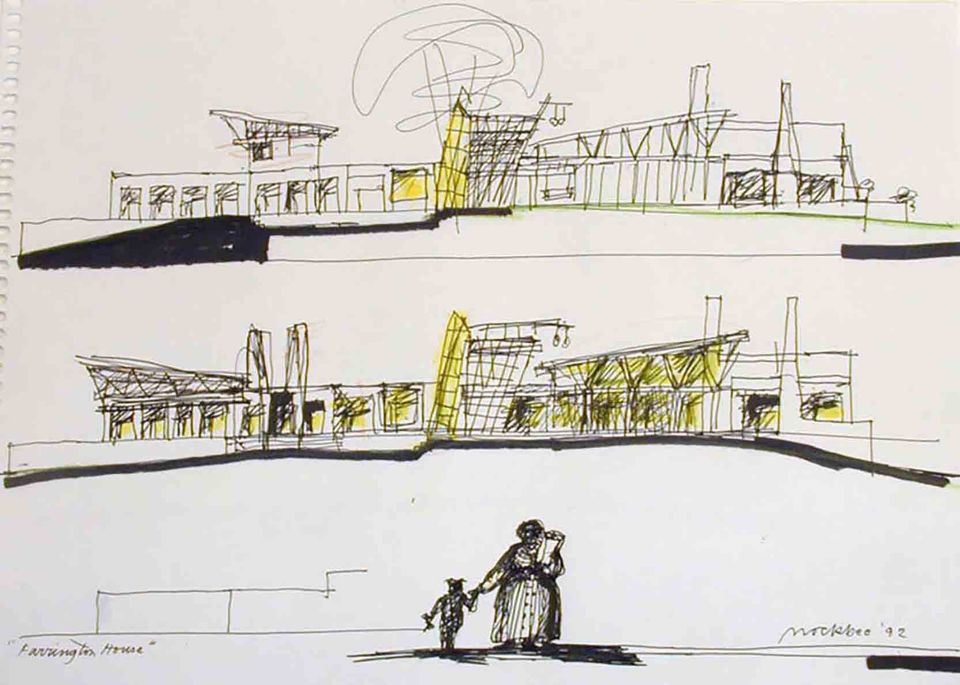Sketching: the emotion in architecture
Website Editor • February 26, 2020
Why sketching is an important tool to any architect.
Is sketching or drawing irrelevant in a world of technology?
Architect-academic Michael Graves disagrees: “architecture cannot divorce itself from drawing, no matter how impressive the technology gets. Drawings are not just end products: they are part of the thought process of architectural design.”
The ability to sketch (with or without technology) enables you capture ideas as they flow, to record the thought process at the time of inspiration when the hand comes into accord with the heart.
Sketching also offers a very effective means of communication for conveying ideas, concepts or solutions quickly to colleagues, clients or contractors.
So, whether you want to visualise your thoughts more or enhance your communication skills, here are some tips for improving your technique your skill in drawing.
Copy and trace
In developing your skills you can — as an exercise — learn a lot by copying the drawings of other illustrators and designers. Tracing helps you identify how certain effects are achieved. Using a grid helps you examine detail and technique.
Record your progress
Keeping a sketchbook and making a habit of taking it with you wherever you go means you can sketch whenever you want. This record of your work is a good motivator as you assess how your skill develops over time.

Attend a class
A taught class or course is surefire way to learn from an expert, to develop and improve your style and to get inspiration from others.
Alternatively, online tutorials
and resources
provide a great breadth of tips, skills and information and inspiration for all over the world. Bob Borson’s ‘Life of an Architect’ website
offers a great deal of professional detail on, among other topics architectural sketching and is well worth a visit.
Draw what you see, not what you think you see.
This may always be a challenge but it is important for speed and efficiency to be able to sketch rough at pre-concept stage. With time and practice, your rough will become smooth!
Practice makes perfect
Draw when you can and wherever you can. Practice drawing different shapes, forms, and textures. Start simple and build, over time, to complexity through setting setting goals for speed, legibility, consistency etc. Experiment with different tools such as pencils, pens, felt tips, and styli. Practice on different media such as paper digital tablet and even your smart phone.
“The initial sketch is always an emotion, not a concept” - Samuel Mockbee.
Articles

The United Nations has described the disruption to education caused by the pandemic as ‘unparalleled’. At the virus’ worldwide peak in April, it is estimated that over 90% of all enrolled learners, from kindergarten to bachelors and beyond, had their education affected by school closures and the pandemic (UNESCO). For many university students and older children, they have had to adapt quickly to online learning. They can keep in touch with their peers and teachers online and continue their studies, albeit in a highly modified way. As challenging as this may be, this experience will help equip them for a future that is increasingly online. For parents of younger children, they are assuming a new role: their child’s home school teacher. This is in addition to their usual childcare and household duties, their work responsibilities and often emotional and financial worries caused by the pandemic. Stressful? Yes. The good, and somewhat surprising, news? The experts advise that you don’t teach your children - at least not in the way you might expect.

If the recent outbreak of Covid-19 has taught us anything, it's that many adults do not wash their hands effectively. It has never been more important that we support our children to develop good personal hygiene to keep themselves and our families safe. This seemingly easy task can be very difficult for children with fine motor skill difficulties. In this article, we explore some ideas to support your child with hand washing.

Lockdown has brought the digital future into the now. Online shopping, entertainment, education and more have moved from the periphery to the mainstream to, in many cases, the only option. With the necessity of social distancing looking to continue for many months, it appears that this rapid digital revolution is here to stay. This means that life as we know it, in most of its sectors, has changed forever. In order to survive, businesses are having to adapt rapidly, embrace technology and look to the future. Architecture is no exception. There has been a widespread adoption of technology and VR over the past few months in response to the lockdown across all of society. Elderly grandparents who were once resistant to adopt new technologies talk of “Zooming” and have started video chatting with their family members to combat loneliness. Art galleries that were once considered stuffy or pretentious are now pioneers in VR technology, with Google Art & Culture offering tours of London’s National Gallery or the Musee D’Orsay in Paris. These virtual tours deliver art in a dynamic new way that can be far more engaging than regular photos. Critics have applauded the panoramic and immersive views of gallery building and exhibitions which work well for rendering of 2 dimensional art, however impressions of sculpture is somewhat lacklustre. With VR technology, users can enjoy a truly immersive experience in the comforts, and safety, of their own home. The COVID-19 pandemic has served as an accelerant for the arts and entertainment industries to embrace VR.




